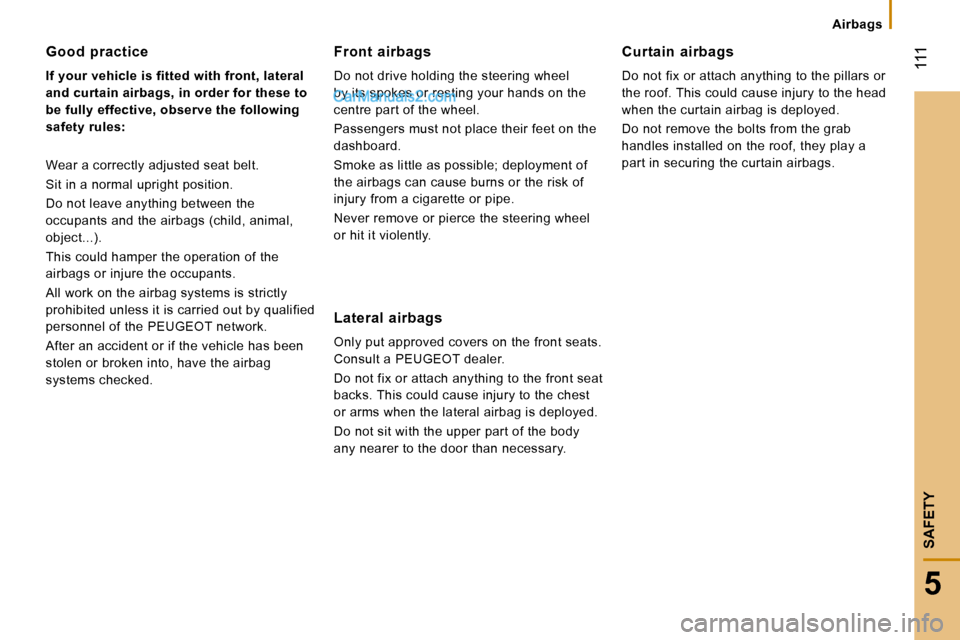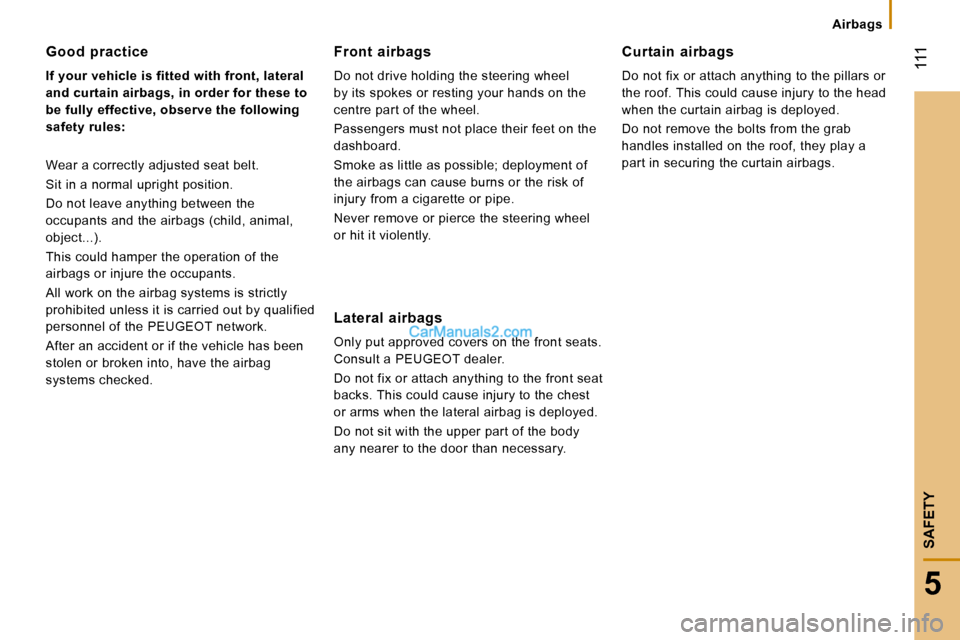Page 108 of 167

Airbags
109
5
SAFETY
AIRBAGS
The airbags have been designed to
maximise the safety of the occupants in the
event of a serious collision; they work in
conjunction with the force limiting seat belts.
In the event of a serious collision, the
electronic detectors record and analyse any
abrupt deceleration of the vehicle:
if the triggering threshold is reached, the
airbags inflate instantly and protect the
occupants of the vehicle.
Immediately after the impact, the airbags
deflate rapidly, so that they do not hinder the
visibility of the occupants nor their possible
exit from the vehicle. The airbags will not be deployed in collisions
which are not serious, for which the seat belt
is sufficient to provide maximum protection.
The seriousness of the collision depends on
the nature of the obstacle and the speed of
the vehicle at the moment of impact.
Airbags
only operate when the ignition is
switched on. Front airbags
These are fitted in the centre of the steering
wheel for the driver and in the dashboard
for the front passenger. They are deployed
simultaneously, except in cases where the
passenger airbag has been deactivated.
The gas escaping from the deployed
airbags can be a minor irritant.
The noise of the detonation may result in a
slight loss of hearing for a short time.
Front airbag fault
If this warning lamp comes on,
contact a PEUGEOT dealer to
have the system checked.
Page 110 of 167

Airbags
111
5
SAFETY
Good practice
If your vehicle is fitted with front,
lateral
and curtain
airbags
, in order for these to
be fully effective, observe the following
safety rules:
Wear a correctly adjusted seat belt.
Sit in a normal upright position.
Do not leave anything between the
occupants and the airbags (child, animal,
object...).
This could hamper the operation of the
airbags or injure the occupants.
All work on the airbag systems is strictly
prohibited unless it is carried out by qualified
personnel of the PEUGEOT network.
After an accident or if the vehicle has been
stolen or broken into, have the airbag
systems checked.
Front airbags
Do not drive holding the steering wheel
by its spokes or resting your hands on the
centre part of the wheel.
Passengers must not place their feet on the
dashboard.
Smoke as little as possible; deployment of
the airbags can cause burns or the risk of
injury from a cigarette or pipe.
Never remove or pierce the steering wheel
or hit it violently.
Lateral airbags
Only put approved covers on the front seats.
Consult a PEUGEOT dealer.
Do not fix or attach anything to the front seat
backs. This could cause injury to the chest
or arms when the lateral airbag is deployed.
Do not sit with the upper part of the body
any nearer to the door than necessary.
Curtain airbags
Do not fix or attach anything to the pillars or
the roof. This could cause injury to the head
when the curtain airbag is deployed.
Do not remove the bolts from the grab
handles installed on the roof, they play a
part in securing the curtain airbags.
Page 112 of 167

Airbags
111
5
SAFETY
Good practice
If your vehicle is fitted with front,
lateral
and curtain
airbags
, in order for these to
be fully effective, observe the following
safety rules:
Wear a correctly adjusted seat belt.
Sit in a normal upright position.
Do not leave anything between the
occupants and the airbags (child, animal,
object...).
This could hamper the operation of the
airbags or injure the occupants.
All work on the airbag systems is strictly
prohibited unless it is carried out by qualified
personnel of the PEUGEOT network.
After an accident or if the vehicle has been
stolen or broken into, have the airbag
systems checked.
Front airbags
Do not drive holding the steering wheel
by its spokes or resting your hands on the
centre part of the wheel.
Passengers must not place their feet on the
dashboard.
Smoke as little as possible; deployment of
the airbags can cause burns or the risk of
injury from a cigarette or pipe.
Never remove or pierce the steering wheel
or hit it violently.
Lateral airbags
Only put approved covers on the front seats.
Consult a PEUGEOT dealer.
Do not fix or attach anything to the front seat
backs. This could cause injury to the chest
or arms when the lateral airbag is deployed.
Do not sit with the upper part of the body
any nearer to the door than necessary.
Curtain airbags
Do not fix or attach anything to the pillars or
the roof. This could cause injury to the head
when the curtain airbag is deployed.
Do not remove the bolts from the grab
handles installed on the roof, they play a
part in securing the curtain airbags.
Page 121 of 167
120
Towing a trailer
TOWING A TRAILER, CARAVAN, BOAT, ETC...
For more information about weights,
refer to the administrative documents
(V5 registration document, ...)
Distribution of loads: distribute the load in
the trailer so that the heaviest objects are as
close as possible to the axle and the nose
weight is close to the maximum authorised
without, however, exceeding it. Driving advice
A towed vehicle must free wheel: gearbox in
neutral.
Page 123 of 167

Equipment
122
ROOF BARS
To install the transverse roof bars, use the
fixings provided for this purpose. Refer to the "Dimensions" section
of chapter 9 for further information
regarding the length (L1 to L4) and the
height (H1 to H3) of the vehicle.
Never exceed the maximum weight of the
vehicle when loaded (GVW).
OTHER ACCESSORIES
These accessories and parts, having been
tested and approved for reliability and
safety, are all adapted to your vehicle.
A wide recommended range and original
parts are offered.
Range of professional equipment Maximum useful load on the roof bars:
100 kg distributed, regardless of the type of
vehicle.
The roof bars can only be installed on the
H1 and H2 vehicles.
Parts and Service technical information
publishes an accessories catalogue offering
various equipment and fittings, such as:
Roof bars for short, medium and long
wheelbase (load retainers for all models).
Foot board, loading roller, step.
Towbar, 7/13 pin, 7/7 pin, 13 pin towbar
harness: trailer towbar which must be fitted
by the PEUGEOT network.
Roof bars for the various heights, additional
roof bar.
Separation partitions, protective floor,
non-slip floor.
Page 124 of 167

Equipment
122
ROOF BARS
To install the transverse roof bars, use the
fixings provided for this purpose. Refer to the "Dimensions" section
of chapter 9 for further information
regarding the length (L1 to L4) and the
height (H1 to H3) of the vehicle.
Never exceed the maximum weight of the
vehicle when loaded (GVW).
OTHER ACCESSORIES
These accessories and parts, having been
tested and approved for reliability and
safety, are all adapted to your vehicle.
A wide recommended range and original
parts are offered.
Range of professional equipment Maximum useful load on the roof bars:
100 kg distributed, regardless of the type of
vehicle.
The roof bars can only be installed on the
H1 and H2 vehicles.
Parts and Service technical information
publishes an accessories catalogue offering
various equipment and fittings, such as:
Roof bars for short, medium and long
wheelbase (load retainers for all models).
Foot board, loading roller, step.
Towbar, 7/13 pin, 7/7 pin, 13 pin towbar
harness: trailer towbar which must be fitted
by the PEUGEOT network.
Roof bars for the various heights, additional
roof bar.
Separation partitions, protective floor,
non-slip floor.
Page 134 of 167
133
QUICK HELP
8
Changing a wheel
1. PARKING THE VEHICLE
As far as possible, park the vehicle on level,
stable and non-slippery ground.
Apply the parking brake, switch off the
ignition and engage first gear.
Put on a high visibility jacket and position
the warning triangle.
If possible, place a chock under the
wheel diagonally opposite the wheel to be
changed. 2. TOOLS
These are located under the front passenger
seat cushion.
- Turn the button a quarter of a turn then pull the box.
- After use, press the button then turn it a quarter of a turn to secure the box.
A. Extended socket.
B. Ratchet wrench.
C. Jack.
D. Towing hook.
E. Wheelbrace.
F. Screwdriver.
CHANGING A WHEEL You must ensure that the occupants get out
of the vehicle and wait in a safe location.
Page 135 of 167
Changing a wheel
4. OPERATING PROCEDURE
- Remove the trim using the screwdriver F
as a lever.
-
Release the bolts using the wheelbrace E .
- Position the jack C at one of the four
locations provided on the underbody
near the wheels. 3. SPARE WHEEL
The spare wheel retaining bolt is located on
the rear right side.
- Turn the bolt using the socket A and the
ratchet wrench B to release the wheel.
- Turn to the locking point, indicated by an increase in the force required for the
manoeuvre. - Take out the spare wheel using the
wrench.
- Unscrew the handle G and remove the
support H .
- Release the spare wheel and place it near the wheel to be changed. If you have a retractable foor board, the jack
must be positioned at 45°.
- Extend the jack using the ratchet
wrench B until the wheel is a few
centimetres off the ground.
- Unscrew the bolts fully and change the wheel.